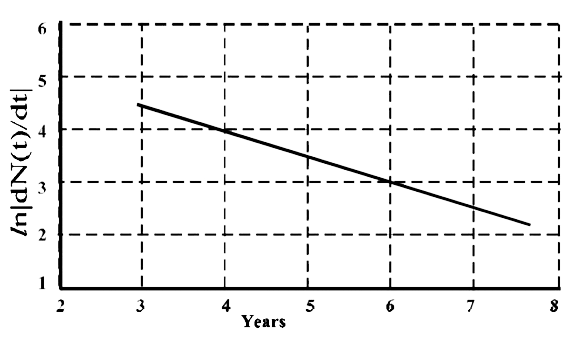To determine the half life of a radioactive element, a student plots a graph of In ∣∣∣dN(t)dt∣∣∣ versus t. Here dN(t)dt is the rate of radioactive decay at time t.

If the number of radioactive nuclei of this element decreases by a factor of p after 4.16 years. the value of p is...........
3
5
7
8
The correct Answer is:D
In A=−λt+C
⇒ln(dN(t)/dt]=−λt+C
λ=[(4−3)/(6−4)]=12(from graph)
We have, t1/2=ln2/λ=1.396
N=N0/23=N0/8
P=8
Topper's Solved these Questions
- BOOK - MODERN PUBLICATIONCHAPTER - ATOMS, MOLECULES AND NUCLEIEXERCISE - MCQ (Level -III)9videos
ATOMS, MOLECULES AND NUCLEI
- BOOK - MODERN PUBLICATIONCHAPTER - ATOMS, MOLECULES AND NUCLEIEXERCISE - Recent Competitive Questions40videos
ATOMS, MOLECULES AND NUCLEI
- BOOK - MODERN PUBLICATIONCHAPTER - ATOMS, MOLECULES AND NUCLEIEXERCISE - Recent Competitive Questions40videos
ATOMS, MOLECULES AND NUCLEI
- BOOK - MODERN PUBLICATIONCHAPTER - 15 MAGNETIC EFFECTS OF CURRENTSEXERCISE - Recent Competitive Questions31videos
15 MAGNETIC EFFECTS OF CURRENTS
- BOOK - MODERN PUBLICATIONCHAPTER - CURRENT ELECTRICITYEXERCISE - RECENT COMPETITIVE QUESTIONS32videos
CURRENT ELECTRICITY
Similar Questions
To determine the half life of a radioactive element , a student plot a graph of in ∣∣∣dN(t)dt∣∣∣ versus t , Here ∣∣∣dN(t)dt∣∣∣ is the rate of radiation decay at time t , if the number of radioactive nuclei of this element decreases by a factor of p after 4.16year the value of p is
 View Solution
View SolutionTo determine the half life of a radioactive element , a student plot a graph of in ∣∣∣dN(t)dt∣∣∣ versus t , Here ∣∣∣dN(t)dt∣∣∣ is the rate of radiation decay at time t , if the number of radioactive nuclei of this element decreases by a factor of p after 4.16year the value of p is
 View Solution
View Solution
Knowledge Check
- Question 1 - Select One
The t0.5 of a radioactive element is related to its average life by the expression
AT12=1.44TavBT12=1.36TavCT12=0.693TavDT12=Tav0.693 - Question 2 - Select One
The half life of a radioactive substance is T0. At t=0,the number of active nuclei are N0. Select the correct alternative.
AThe number of nuclei decayed in time internal 0−t is N0e−λtBThe number of nuclei decays in time interval 0−t is N0(1−e−λt)CThe probability that a radioactive nuclei does not decay in interval 0−t is e−λtDThe probability that a radioactive nuclei does not decay in interval 1−e−λt - Question 3 - Select One
The half life of a radioactive element is T and its initial activity at t=0 is A0 and at t=t it is A, then
AA=A02t/TBA=A0(2t)TCA0=A2t/TDA0=A2−t/T
To determine the half life of a radioactive element , a student plote a graph of in ∣∣∣dN(t)dt∣∣∣versust,Here∣∣∣dN(t)dt∣∣∣ is the rate of radioatuion decay at time t , if the number of radoactive nuclei of this element decreases by a factor of p after 4.16 year the value of p is
 View Solution
View SolutionDraw a graph showing the variation of decay rate (−dNdt) with number (N) of radioactive nuclei.
View SolutionThalassemia and sickle cell anemia are caued due to problem in globin molecule synthesis . Select the correct statement.
View SolutionThe graph between number of decayed atoms N' of a radioactive element and time t is.
View SolutionIf −(dNdt)o is the initial activity and −(dNdt) is the activity at time t in a radioactive disintegration then :
View Solution

